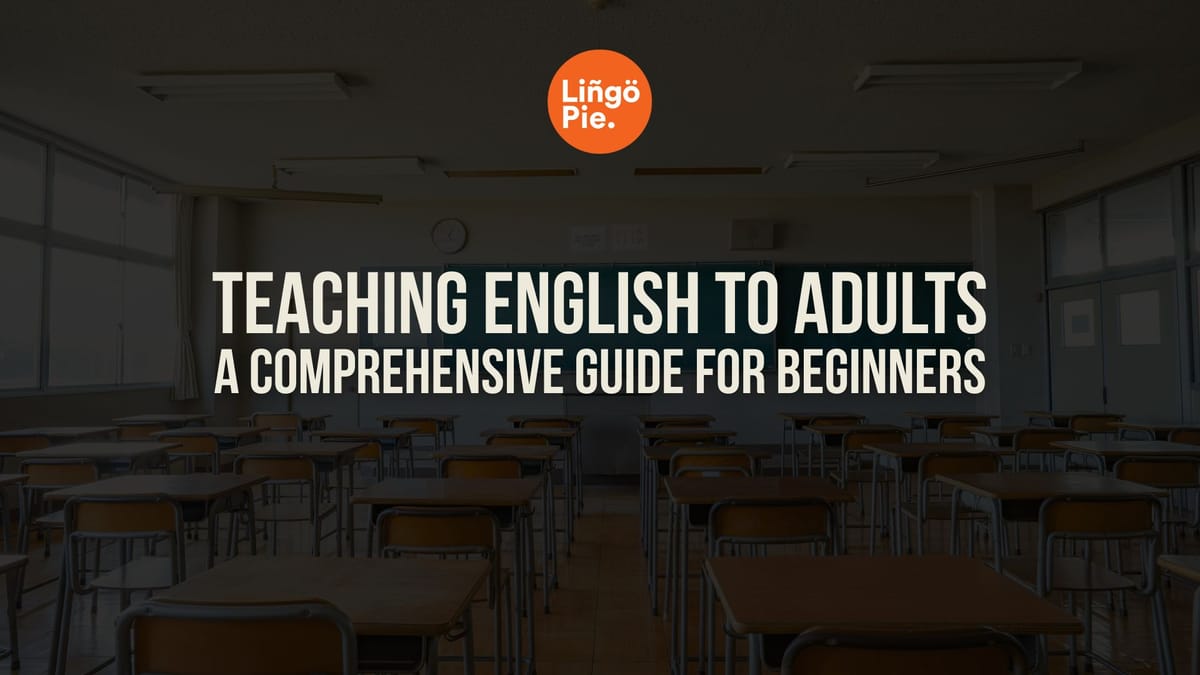Welcome, fellow educators! We are here to show you how to elevate your teaching game in 2024 with innovative tips and tools designed to make adult language learning a dynamic and enjoyable experience.
We've curated a toolkit to empower you in meeting the diverse needs of adult learners. Let's dive into some game-changing strategies and you will see just how much fun your students will have.

1. Mix Up Your Lessons for Engaged Learning

Teaching English to adult learners is an art that thrives on variety. Diverse activities tailored to their specific needs create an environment where learning becomes an engaging journey.
Try infusing real-world scenarios into your lessons, such as simulating a visit to an English-speaking country.
Picture your students ordering food, navigating through streets, and engaging in conversations—making language acquisition not just educational but profoundly practical.
Example: Restaurant Scenario
Activity: Role-play a restaurant scenario where students take on different roles, play customers, and practice ordering food in English. This not only hones language skills but also builds confidence in real-life situations.
Engage with Real-World Scenarios:
Connect language to everyday experiences, making the learning journey both relatable and enjoyable. This approach helps adult learners see the immediate application of their language skills, motivating them to actively participate in lessons.
2. Leverage Lingopie for Vocabulary Enhancement
Nowadays there are so many language learning tools, but, Lingopie stands out as a powerful ally for vocabulary enrichment.
From time to time, you can integrate Lingopie into your lessons, transforming your classroom into an interactive hub of language exploration.
Lingopie offers curated videos with interactive subtitles, allowing students to learn contextually.
Example: Business English Learning
Scenario: Introduce a Lingopie video focusing on business English. Students watch a scenario where professionals engage in a meeting, exposing them to industry-specific vocabulary and communication etiquette.
Transform Language Learning into an Experience:
Lingopie turns language learning into an immersive journey. The interactive subtitles and diverse content options cater to different learning styles, ensuring that each student finds an engaging pathway to enhance their language skills.
3. Foster Connection in the Digital Classroom

Creating connections in a virtual space is a skill that transforms a mere online class into a thriving community.
Imagine starting your lessons with a few minutes of small talk, bridging the digital gap between you and your adult learners.
Utilize technology, such as discussion rooms or chat streams, to ensure that all students actively participate.
Example: Personalized Feedback Session
Strategy: Conduct personalized feedback sessions, either through private messages or discussion boards. This not only provides constructive feedback but also allows you to acknowledge individual progress.
Building Relationships in the Digital Space:
When you decide to teach adults you have to take a different approach. Adults expect more than kids. Sharing personal stories, asking about students' interests, and actively engaging in discussions outside the lesson content contribute to a vibrant digital learning community.
4. Keep Adult Students Busy for Maximum Engagement
Adult learners have diverse responsibilities, making engagement a constant challenge. You should focus on planning a variety of activities tailored to different learning styles, ensuring a pace that keeps distractions at bay.
Starting classes promptly, respecting your students' time, and incorporating off-screen activities for short breaks are essential strategies for maintaining focus.
Example: Role-Playing Exercises
Activity: Introduce role-playing exercises related to real-world scenarios. For instance, simulate a job interview, where students practice answering common questions and discussing their professional background.
Dynamic Learning Experiences:
By incorporating activities that resonate with adult learners' interests and goals, you create an environment where they actively participate, ensuring that every moment in class contributes to their language development.
5. Amplify Learning with Audiobooks

Audiobooks offer a gateway to a unique auditory language experience. Listening to a book in a foreign language can be challenging but it will be very useful.
The best way would be to elect audiobooks aligned with your student's interests from platforms like Audible or Librivox.
Integrating audiobooks into lessons becomes an opportunity for interactive sessions, encouraging discussions and enhancing comprehension.
Example: Cultural Insights through Audiobooks
Application: Choose an audiobook that delves into cultural nuances. After listening, initiate discussions on the cultural aspects explored in the audiobook, encouraging students to share their perspectives.
Immersive Learning Beyond the Classroom:
Audiobooks not only enhance listening skills but also open avenues for exploring cultural contexts. Encourage students to explore audiobooks independently, making language learning a flexible and enjoyable experience.
6. Engage Adult Learners with Real-World ESL Scenarios
Teaching ESL is not just about language; it's about immersing students in real-life situations. When you decide to teach ESL you must prepare your students for some real-life scenarios.
The best way to achieve that is by crafting lessons that mirror their everyday experiences, making language learning not just theoretical but practical.
Simulating scenarios like ordering food or navigating public transport enhances language skills and fosters confidence in using English beyond the classroom.
Example: Virtual Exploration of English-Speaking Countries
Activity: Conduct a virtual exploration where students "visit" an English-speaking country. Discuss scenarios like ordering food, asking for directions, and engaging in everyday conversations.
Connecting Language to Daily Life:
By immersing students in real-world scenarios, you bridge the gap between theory and application, making language learning a living experience rather than a theoretical exercise.
7. Tailor Business English Lessons for Professional Growth

Teaching business English involves more than language; it's about equipping adult learners for professional success.
No matter what they do in their current job - everybody can benefit from a second language. Especially if that language is English.
The best way to teach business English is by tailoring lessons to cover industry-specific vocabulary, communication etiquette, and cultural nuances.
Conducting mock business meetings or presentations becomes a crucial aspect of this specialized approach, ensuring that students acquire the language tools needed for success in a professional setting.
Example: Mock Business Meetings
Activity: Organize a mock business meeting where students play different roles. This not only exposes them to business English vocabulary but also hones their communication skills in a professional context.
Practical Skills for Professional Success:
Tailoring lessons to meet the specific needs of adult learners aiming for professional success ensures that their language development aligns with their career aspirations.
8. Set Clear Expectations for Adult ESL Learners
Creating a transparent learning environment involves setting clear expectations from the outset. Some of your ESL classes should be focused on outlining course objectives, detailing lesson structures, and encouraging open communication.
Providing additional resources, such as recommended reading or online language tools, becomes a proactive approach to supporting their learning journey.
Example: Additional Resources for Further Learning
Guidance: Recommend online platforms, books, or language exchange programs that align with individual learning styles. Encourage students to explore these resources beyond the classroom.
Empowering Learners Beyond the Classroom:
Setting clear expectations not only fosters a positive and collaborative atmosphere but also empowers learners to take charge of their language journey. By providing additional resources, you ensure that their learning extends beyond the confines of the classroom.
Summing up: How to Teach English to Adults in 2024
In essence, teaching English to adult learners is a dynamic process that involves creativity, adaptability, and a genuine understanding of your students' needs.
The strategies and tools like Lingopie that we showed you above go beyond the conventional, aiming to create an immersive and enjoyable learning experience.
As you embark on this teaching journey, remember that each interaction is an opportunity to not just impart knowledge but to inspire and empower your adult learners on their language-learning adventure.
FAQs Regarding Teaching Adults and Adult ESL Students
In this section, we answer commonly asked questions relating to the topic of how to teach English to adults.
How do I start teaching English to adults for beginners?
Begin by understanding adult learners' needs, focusing on real-world scenarios. Design dynamic lesson plans for daily situations using visual aids. For beginners, ease into English through practical applications, such as grocery shopping or cafe interactions. Emphasize cultural relevance and engage with false beginners, recognizing their prior exposure to the language.
How do you teach an adult English conversation?
Teaching English conversation to adults involves fostering an interactive environment. Encourage discussions on diverse topics, incorporating news articles or relevant videos. Tailor lessons to individual interests, providing a platform for expressing opinions. Engage adult learners in conversational activities, building their confidence and ensuring a dynamic exchange aligned with the expectations of adult ESL students.
What can I teach an adult English?
Teach a range of English skills tailored to adult learners' goals. Start with basics for beginners, progressing to advanced topics. Cover practical language applications, business English, and cultural nuances. Utilize Lingopie for vocabulary enhancement through enjoyable content. Address individual needs, offering a well-rounded curriculum that aligns with the diverse expectations and interests of adult English learners.
Is teaching children easier than teaching adults?
Teaching children and adults presents distinct challenges. While children may exhibit greater flexibility in language acquisition, adults often possess developed cognitive skills. Adult learners, motivated by personal goals, can actively engage in the learning process. Ultimately, the ease of teaching depends on the educator's approach, adaptability, and understanding of each group's unique learning characteristics.
What qualifications do I need to teach English to adults?
To teach English to adults, consider earning a TEFL certification. Completing a TEFL program equips you with essential skills for effective adult language instruction. Additionally, familiarity with the nuances of English-speaking countries and other students' needs enhances your qualifications. These certifications validate your expertise, ensuring you meet the standards for teaching adult learners.




![How To Do The Mexican Accent [Complete Guide]](/blog/content/images/2024/06/Understanding-Mexican-Spanish-Accents.jpg)
![7 Best Language Learning Apps In 2026 [+ Free Cheat Sheet]](/blog/content/images/size/w1200/2022/11/The-7-Best-Language-Learning-Apps-for-Foreign-Language-Learning.png)


![Improve Your English Listening Comprehension [2026 Guide]](/blog/content/images/size/w300/2023/12/5D8A320F-7EF3-4F0F-9EDD-0F91C9504FA0.png)
![4 Hacks to Learn English With Movies [2026 Guide]](/blog/content/images/size/w300/2023/10/88AAD01A-8BF3-4648-82CC-639C1B240C28.png)